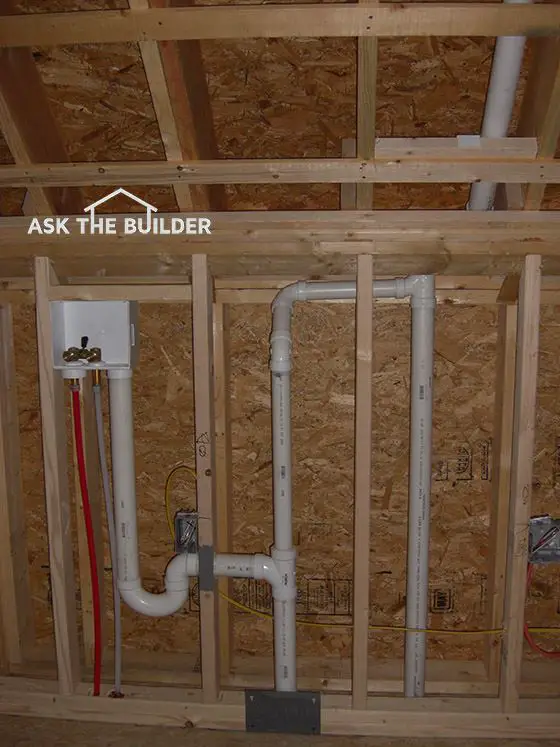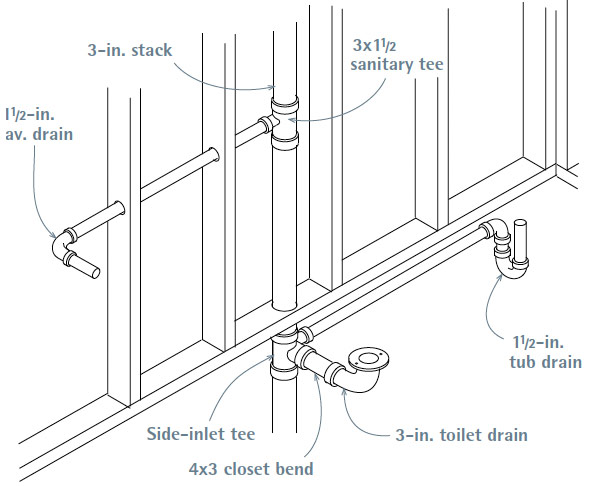Correct Ventilation in Plumbing Systems: How It Matters
Correct Ventilation in Plumbing Systems: How It Matters
Blog Article
They are making several great pointers on What Are Plumbing Vents and Why Are They Important? in general in the content on the next paragraphs.

Proper air flow in plumbing systems is usually neglected, yet it is crucial for keeping the capability and security of your home's plumbing. Ventilation assists regulate atmospheric pressure, stop the buildup of hazardous gases, and guarantee the efficient elimination of waste. In this guide, we will check out the significance of appropriate plumbing ventilation, how it works, and the benefits it gives your plumbing system.
Recognizing Air Flow in Plumbing
Ventilation in plumbing refers to the network of pipes that permit air to move via the water drainage system. These vents offer numerous functions, including regulating atmospheric pressure within the pipelines, stopping drain gases from entering the home, and aiding in the smooth circulation of wastewater.
Exactly How Ventilation Functions in Plumbing Equipments
Atmospheric Pressure Policy
Proper air flow maintains well balanced atmospheric pressure within the plumbing system. When water moves with pipes, it displaces air. Without appropriate ventilation, this displacement can create unfavorable pressure, causing slow down drains or siphoning of water from catches, which can trigger unpleasant odors to permeate right into the home.
Preventing Drain Gas Buildup
One of one of the most critical features of pipes vents is to avoid drain gases, such as methane and hydrogen sulfide, from accumulating within the home. These gases can position severe wellness threats and are highly flammable. Vent pipes permit these gases to escape securely outdoors.
Helping in Waste Removal
Ventilation assists in the reliable removal of wastewater by avoiding airlocks in the drainage system. When air can flow openly via the vents, it permits water and waste to move efficiently with the pipelines, reducing the threat of blockages and backups.
Kinds Of Plumbing Vents
Main Heap Vent
The primary stack air vent, additionally called the vent stack, is the main air vent in a pipes system. It extends from the main drainpipe line up through the roofing, permitting gases to get away and fresh air to get in the system.
Branch Vent
Branch vents attach to the major stack vent and serve specific fixtures, such as sinks, bathrooms, and showers. These vents make certain that each fixture has sufficient ventilation to work effectively.
Air Admission Valve (AAV).
An Air Admittance Valve (AAV) is a one-way shutoff that permits air to enter the plumbing system without the demand for a conventional vent pipe prolonging through the roofing system. AAVs are frequently utilized in remodellings or locations where mounting a standard vent is not practical.
Signs of Poor Ventilation in Pipes.
Slow Draining Fixtures.
If your sinks, tubs, or bathrooms are draining gradually, maybe an indication of bad ventilation. Inadequate air circulation can develop a vacuum cleaner impact, making it challenging for water to drain pipes correctly.
Gurgling Appears.
Gurgling sounds originating from drains are often an outcome of air being sucked with water catches due to unfavorable stress in the pipelines. This is a clear indicator of inadequate air flow.
Undesirable Odors.
Sewer smells inside your home are a red flag that your plumbing system is not appropriately aerated. This can suggest that drain gases are not being sufficiently aired vent outside, resulting in possibly dangerous problems.
Usual Ventilation Blunders.
Poor Vent Sizing.
Utilizing undersized vent pipes can result in poor air flow and pressure inequalities in the system. It's important to utilize vents that fulfill the certain needs of your pipes system.
Improper Vent Positioning.
Positioning vents also far from the fixtures they offer can minimize their efficiency. Proper positioning makes sure that air can flow openly and efficiently with the system.
Ignoring Code Demands.
Building codes give particular guidelines for pipes ventilation. Neglecting these codes can cause a system that fails to work properly and might cause pricey repair services or carcinogen.
Advantages of Correct Air Flow.
Boosted System Performance.
Correctly ventilated pipes systems run extra successfully, with less obstructions, faster draining pipes, and much less strain on the pipes. This efficiency expands the life-span of the pipes system.
Improved Air Top Quality.
By preventing sewage system gases from entering your home, correct air flow adds to much better indoor air quality, making your living setting healthier and extra comfortable.
Preventing Water Damages.
Appropriate air flow helps stop water from being siphoned out of traps, which can bring about sewage system gases going into the home and causing water damages with time.
Steps to Ensure Correct Air Flow.
Consulting Plumbing Codes.
Always seek advice from neighborhood pipes codes when developing or modifying your pipes system. These codes offer the essential standards for proper venting and ensure your system satisfies safety criteria.
Routine Evaluation and Upkeep.
Regular examinations can assist determine potential ventilation concerns before they end up being significant problems. Upkeep tasks, such as cleaning up air vent pipes and looking for clogs, are crucial for maintaining the system in good working order.
Expert Installment.
For new setups or significant adjustments, it's important to work with a specialist plumber. They have the knowledge to make sure the ventilation system is appropriately designed and installed according to code.
Final thought.
Appropriate ventilation is a critical component of any kind of plumbing system, guaranteeing that it operates successfully and safely. By understanding the importance of ventilation, identifying the indicators of bad ventilation, and taking actions to keep your system, you can avoid expensive concerns and safeguard your home's air high quality.
4 Things You Should Know About Your Plumbing Vents
What Plumbing Vents Are
Also called a vent stack, a plumbing vent is a vertical pipe attached to your drain line that runs through your roof. The plumbing vent pipe, or plumbing air vent, removes gas and odors from your plumbing system and allows fresh air to enter the pipes, helping the water to flow out of the drain pipes.
What Plumbing Vents Do
Plumbing vents have two basic functions. One of which is to allow unpleasant smelling wastewater and sewer gasses to escape your plumbing system instead of entering your home. Plumbing vent pipes are typically located on roofs, away from windows, to ensure the fumes exit the home completely.
The other function of the plumbing vent is to move fresh air into your plumbing system. This helps move water through every plumbing fixture in your house, like toilets and sink drains. Think of the way in which you need to let a little air into the bottle as you pour soda in order to make the drink flow smoothly.
Different Types of Plumbing Vents
True vent: This is the most common vent option. In simplest terms, a true vent is a vertical pipe attached to your drain line that exits through the roof. They often function as the main vent that other fixtures can connect to. Re-vent pipe or auxiliary vent: Attached to the drain line near specific plumbing fixtures, re-vent pipes run up and over to connect to the main vent. Common vent: Two plumbing fixtures installed on opposite sides of a wall are typically tied into the vent stack using something known as a sanitary cross. Wet vent: This venting option operates as a drain pipe and a vent at the same time. Wet vent drainage systems drain water from one fixture while venting the air from another. Although they’ve been used for over 100 years, wet vent systems have only recently been added to the plumbing code in many areas. If you’re planning on installing one in a bathroom remodel, make sure you check your local code prior to construction. Loop vent: For free-standing fixtures like kitchen island sinks, loop vents are ideal. These vent pipes run under the floor, rise from the P-trap, and create a loop inside the cabinet sink. Air admittance valve: An AAV is a one-way mechanical valve typically installed at the site of the plumbing fixture. AAVs allow venting to occur without having to tie into a larger venting system. They’re ideal for venting fixtures where you aren’t able to easily connect to an existing vent system. Common Plumbing Vent Issues
Although vent pipes typically don’t have water flowing through them, they’re still subject to many typical plumbing issues. For example, clogs are one of the most common problems associated with sewer vent pipes. If your vent pipe gets clogged, all of your plumbing fixtures tied into the vent stack will be affected.
A sink with a slow drain that bubbles and gurgles or a strong sewage smell around your toilet are both indicators that your toilet vent pipe is clogged. Because most vent pipes exit through the roof, old leaves, twigs or even a bird’s nest could be clogging the pipe.
Clogs in your vent pipe system cause a buildup of negative pressure, meaning that water won’t be able to flow out of your home very well. It’s similar to putting your finger over the opening of a straw to trap water inside. When you remove your finger, the water is able to flow out of the straw.
If you suspect you have any blockage in your vent, make sure you have a professional come examine the situation. Left unchecked, a blocked air vent can lead to other costly repairs, like leaks and sediment buildup.
Under Pressure
Pipe vents are essential aspects of a home’s plumbing system. Owning a home means learning about all sorts of things you never put much thought into before. But by understanding as much as you can about the important systems of your home, you can keep those budgets intact and those anxiety levels low.
https://www.homeserve.com/en-us/blog/home-improvement/plumbing-vents/

Do you like more info about Why Plumbing Air Vents Are Important? Create feedback down the page. We'd be glad to know your insights about this write up. Hoping that you come back again in the future. Sharing is nice. You never know, you may be helping someone out. We enjoy your readership.
Schedule Your Service Report this page